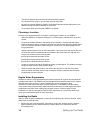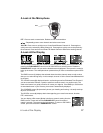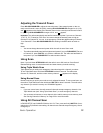14
• The remote speaker wires can be used with an auxiliary speaker.
• All connections are “plug-in” type for easy removal of the radio.
• By using an optional WHAM or WHAM x 4 (Wireless Handheld Access Microphone), the
UM625c can be mounted completely out of the way.
• An accessory flush mount bracket (FMB321) is optional.
Choosing a Location
Here are some important factors to consider in selecting the location for your UM625c.
• While the UM625c is completely waterproof, it will last longer if protected from spray and
splash.
• Connect the UM625c directly to the battery for best operation. Always keep the battery
leads as short as possible. If a direct connection can not be made with the supplied power
lead, any extension should be made using #12-14 AWG wire. Use larger gauge wire for
longer extensions.
• Keep the antenna lead-in wire as short as possible. If you must use a long lead-in wire as in
the case of a sailboat masthead antenna installation, we recommend you upgrade your
lead-in wire according to the following table:
Use RG-58 for distances less than 20 feet.
Use RG-8X for distances less than 35 feet.
Use RG-8U for distances less than 60 feet.
• Locate your antenna as high as possible and clear of metal objects. The reliable coverage
range is a direct function of the antenna height.
• Select a location that allows free air flow around the heat sink on the rear of the radio.
• Select a location well away from the ship's compass. Auxiliary speakers also should be
located away from the compass.
Engine Noise Suppression
Interference from the noise generated by the electrical systems of engines can sometimes be
a problem with radios. The UM625c has been designed to be essentially impervious to ignition
and alternator noise. However, in some installations it may be necessary to take
measures to further reduce the effect of noise interference. The UM625c radio DC battery
wires, antenna lead, and accessory cables should be routed away from the engine and engine
compartment, and from power cabling carrying high currents. In severe cases of noise
interference, it may be necessary to install a noise suppression kit. Contact the dealer from
whom you purchased the radio for more information.
Installing the Radio
After you have carefully considered the various factors affecting your choice of location, follow
these steps to install the radio.
1. Position the radio (with the bracket, microphone, power cord, antenna and any auxiliary
cables installed) into the selected location to assure there is no interference with the
surrounding items.
Setting Up The Radio


















